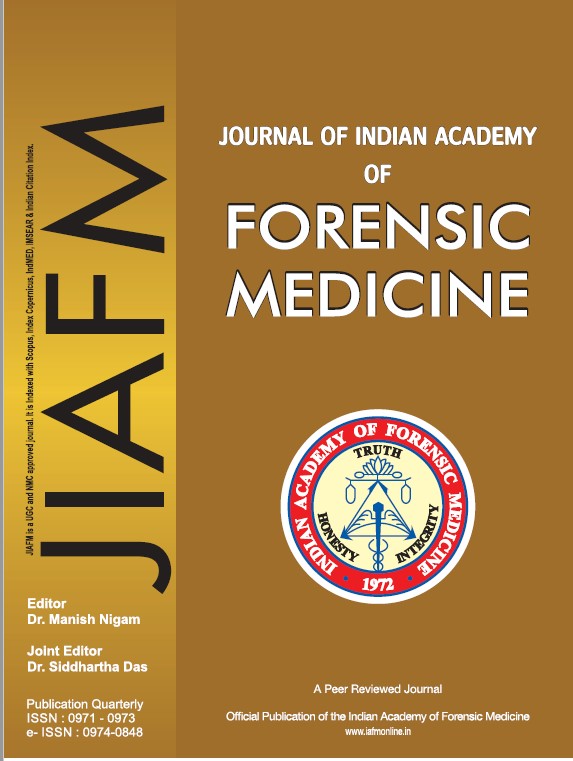An Autopsy Based Study on Pattern of Fatal Injuries in Fall from Height
DOI:
https://doi.org/10.48165/jiafm.2023.45.4.1Keywords:
Fall from height, Minor injuries, Major injuriesAbstract
Falls are the second most common cause of injury-associated mortality after traffic accidents. The present study aims to find out the pattern of injuries among the victims of fall from height. This prospective observational study was conducted among victims of fall from height at SRTR Government Medical College morgue during the period of July 2020 to July 2022. All medico-legal cases involving head injuries brought for autopsy during the study period were included. Exclusion criteria includes all medico-legal cases not involving head injury, advanced decomposed bodies, intracranial haemorrhage, infarctions, lesions as a result of natural disease. Various data were collected. A total of 996 autopsies were performed during the study period out of which 48 (4.82%) were cases of fall from height. Among them 30 (62.5%) were male and 18 (37.5%) victims were female. Most of the victims were day labourer or construction workers 16 (33.33%). Most deaths occurred during day time 35 (72.92%) with highest mortality is due to accidental falls 31 (64.58%). Ages of maximum victims were between 31-40 years (37.5%). All the victims had multiple abrasions and bruises in their body, followed by intra cranial haemorrhage 42 (87.5%), laceration 34 (70.84%) and others. In skull, linear fracture was the commonest one 26 (54.17%). Temporal bone was the commonest bone to fracture 25 (52.08%) and most of the victims 17 (35.42%) had subdural haemorrhage. Most common cause of death is due to major injuries over head 36 (75%). Strategies designed to prevent these falls should have a substantial effect.
Downloads
References
Ersoy S, Sonmez BM, Yilmaz F, Kavalci C, Ozturk D, Altinbilek E, et al. Analysis and injury patterns of walnut tree falls in central anatolia of turkey. World J Emerg Surg. 2014;9:42.
Work Safe BC's 2013 Annual Report. 2013 Statistics Serving British Columbians. Available from: https://www. worksafebc.com/en/search#q=2013%20report&sort= relevancy&f:language-facet=[English]
Kennedy RL, Grant PT, Blackwell D. Low-impact falls: Demands on a system of trauma management, prediction of outcome, and influence of comorbidities. J Trauma. 2001;51 (4):717-24.
Garrettson LK, Gallagher SS. Falls in children and youth. PediatrClin North Am.1985; 32:153–62.
Spiegel CN, Lindaman FC. Children can't fly: a program to prevent childhood morbidity and mortality from window falls. Am J Public Health. 1977; 67:1143–7.
Kohli A, Banerjee KK. Pattern of injuries in fatal falls from
buildings. Med Sci Law. 2006;46(4):335–41.
Yavuz M, Tomruk O, Baydar C, Kupeli A. Evaluation of accidental fall from high cases who admitted to emergency service. Journal of Forensic Medicine. 2004;18:8–12.
Pressley JC, Barlow B. Child and adolescent injury as a result of falls from buildings and structures. Inj Prev. 2005;11(5):267–73.
Faergemann C, Larsen LB. Non-occupational ladder and scaffold fall injuries. Accid Anal Prev. 2000; 32(6):745-50.
Murray JA, Chen D, Velmahos GC, et al. Pediatric falls: Is height a predictor of injury and outcome? Am Surg . 2000; 66(9):863-5.
Tinetti ME, Speechley M, Ginter SF. Risk factors for falls among elderly persons living in the community. N Engl J Med. 1988; 319:1701.
Eren A, Arslan M, Hilal A, Cekin N. Deaths due to fall from a height in Adana. Adli Tıp Bülteni. 2009;14:12–5.
Musemeche CA, Barthel M, Cosentino C, Reynolds M. Pediatric falls from heights. J Trauma. 1991; 31:1347–9.
Meller JL, Shermeta DW. Falls in urban children: a problem revisited. Am J Dis Child .1987; 141:1271–5.
Velcek FT, Weiss A, DiMaio D, Koltz DH Jr., Kottmeir PK. Traumatic death in urban children. J Pediatr Surg. 1977;12: 75–384.
Lehman D, Schonfeld N. Falls from heights: a problem not just in the northeast. Pediatrics.1993; 92: 1–124.
Barlow B, Niemirska M, Gandhi R, Leblanc W. Ten years of experience with falls from a height in children. J Pediatr Surg. 1983; 18:509–11.
Pathak A, Desania NL, Verma R. Prifle of Road Traffic Accidents and Head injury in Jaipur. J Indian Acad Forensic Med. 2008; 30(1):6-10.
Reddy KSN. The Essentials of Forensic Medicine and Toxicology. 31st ed. India: Medical Book Coy. 2013; p.232- 41.
Knight B, Saukko P. Knight's Forensic Pathology. 3rd ed. London :Arnold; 2004. p174-222.
Kleber C, Giesecke MT, Tsokos M, Haas NP, Schaser KD, Stefan P, et al. Overall distribution of trauma-related deaths in Berlin 2010:advancement or stagnation of German trauma management? World J Surg. 2012;36(9):2125–30.


